Gear Info
Soundgas News
Soundgas Type 636 & 636P Update

WRITTEN BY: Tony Miln
UPLOADED: 21st Dec 2021

Over thirty of the initial prototype 636P germanium preamps (based on the Grampian 636 preamp) are now out in the world and making one hell of a racket. We plan to build a short run of pre-production 636Ps to ship in early 2022 and then take a break and build the final Soundgas Type 636 reverbs (delivery May/June 2022). We have enough vintage Gibbs tanks for ten more [UPDATE 4the Jan 2022: 8 ARE NOW SOLD!] which makes a total of around 66 units which feels like a good number to end on. Read on for a 636P progress report: the story so far, happy accidents that are now part of the sound and design, and information on the updates to the 636P design for those heading out early next year. And, if you want a 636P before next summer, or one of the last of the full Type 636 units, you can place your preorder now.
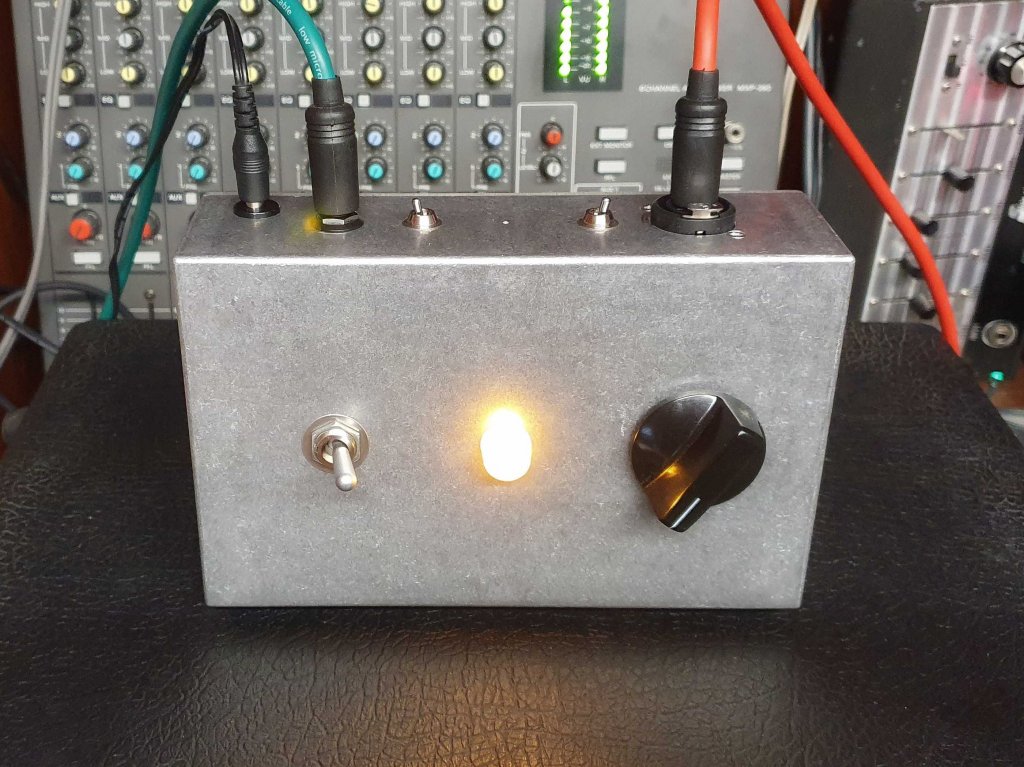
It’s Been A Year…
To say 2021 has been a challenging year is something of an understatement. Bringing new products to market is far from a trivial undertaking at the best of times and this year certainly does not fit that description. On top of the usual trials and tribulations of R&D, the combined impact of Covid19 and Brexit on supply chains has led to component shortages that have necessitated continual rethinks and redesigns along the way.
Keeping upfront costs down is essential for a business like ours to thrive, but this year we’ve had to commit to purchasing much greater quantities of components to ensure we have enough supplies to last for the next six months. Even more so than before, taking preorders for the prototype and early builds of the Type 636P has been vital to keeping the project on track, and we’re grateful for the support and enthusiasm of those who’ve placed early orders.
Riding The Learning Curves
We’ve experienced great disruption to our team because of the pandemic, with the Type 636 and 636P designer, Dr Huw, battling against Long Covid over the past 18 months. Ben Hirst, who originally joined Soundgas as studio engineer just before the pandemic, pivoted his role to become builder and then production manager of the Type 636 project. We learned a great deal (the hard way) from announcing and producing our first product as the world battled Covid19. Ben has worked hard to ensure that the 636P production process benefited from that hard-won experience. He has overseen the entire process and worked tirelessly during the prototyping and development stages to create something that we are all immensely proud of (and that we all love using). Dr Huw’s design has been tweaked and finessed with a few additional features added.
Below: The last 10 of the “prototype” design units being burned in in our studio.
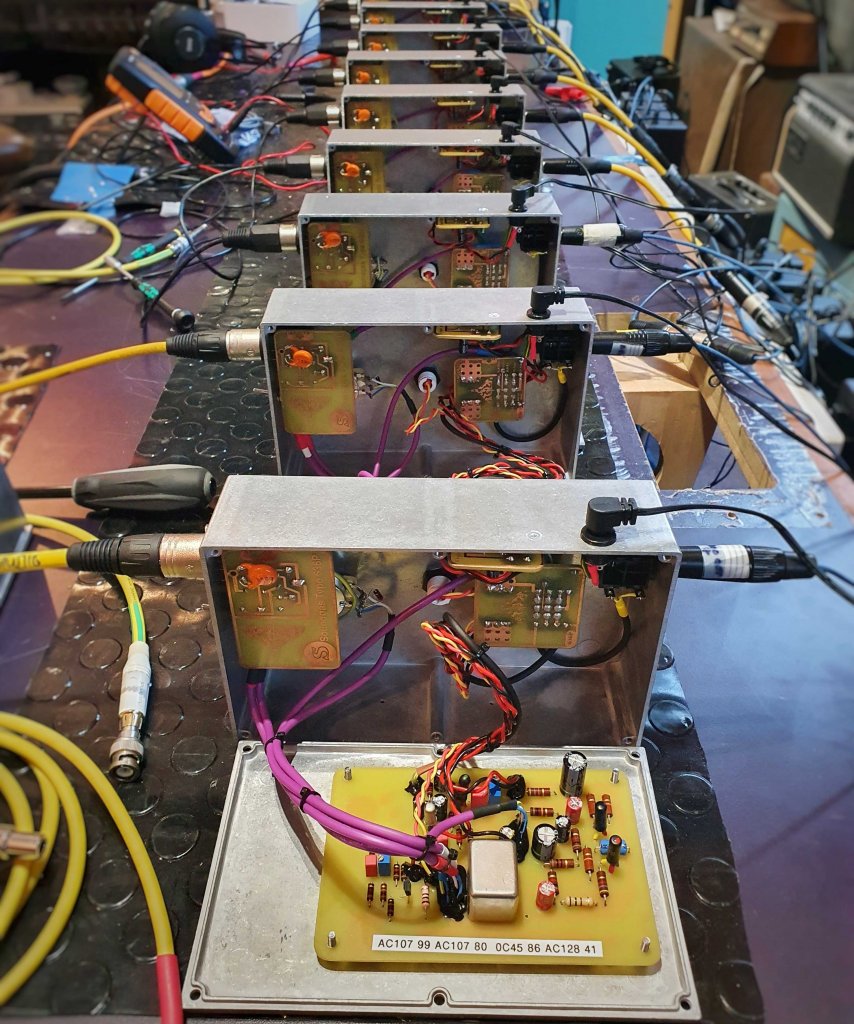
Germanium, Silicon & Happy Accidents
You can find more detail in my previous blog about the development process, especially the germanium vs silicon debate. Along the way the price of the essential vintage germanium transistors we use shot up as they became steadily harder to source. We even ended up going with a germanium buffer circuit, even though it added greatly to the cost, because (as That Pedal Show say) tone! It’s been quite a process and has involved much blood, sweat, tears (and dare we say some profanity and occasional raised voices). Ben’s complete focus has been on delivering the very best sonics and quality possible and he’s been single-minded in pursuit of that goal.
Along the way, serendipity has played a part: my favourite episode from this saga relates to the magic of prototype PETE6 (the P of 636P is in honour of the memory of Ben’s dad, Pete, who sadly passed away this year). PETE6 was by some degree considerably hairier than the other prototypes and Ben had initially assumed that it must have been a particularly special set of germanium transistors. All the transistors are carefully tested and graded, but still perform differently so every 636P has its own unique character (each unit contains four germanium transistors). Testing revealed nothing unexpected from the germanium sections and Ben wondered if the mic input transformer might be responsible (one of my original Grampian Type 636s has a mystery transformer with extra gain which adds another level of filth to proceedings). Swapping it out made no difference: it was still hairier than the rest even with a different transformer. It was only when he was at home one evening that he recalled changing a resistor value in the circuit. Huw had suggested a value which Ben had written down, but he suddenly recalled that when building PETE6 he didn’t have that exact value to hand so went for a close match. This turned out to be the magic ingredient in PETE6 and is now of course part of the final circuit in the units we are building.
Below: The legend that is PETE6, with a very limited edition “friend”…
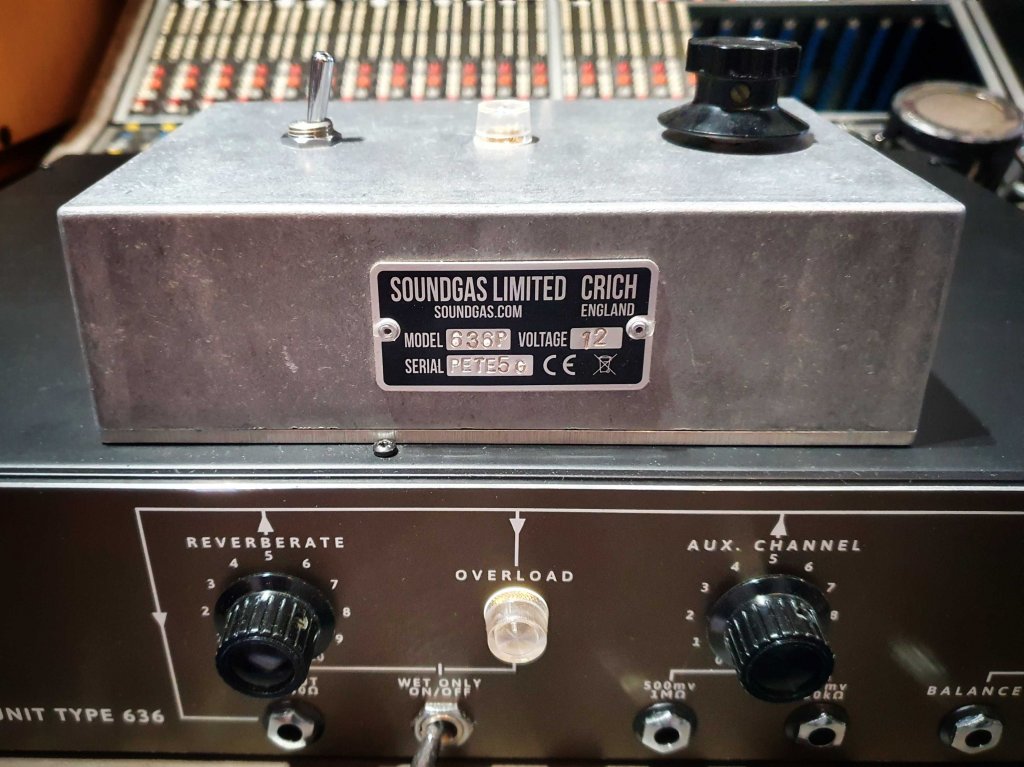
All Stones Turned
The results of this no expense spared, no stone unturned approach are clear from the moment you plug into the 636P: it has all the heft and shit-eating-grin-inducing magic of its big brother, the Type 636 (and great grandfather, the Grampian Type 636). So much so that several customers have ordered a pair (most of them already own a Type 636 – or two) and we’re just starting to hear back from buyers of the first twenty units and the feedback is very positive.
As the owner of serial number 01 reported today:
“this is the best sounding fuzz, distortion/overdrive pre I have ever used, Soundgas really knocked it out of the park.”
During real world testing we were asked why the output was out of phase – something not uncommon in old gear and a feature of the original Grampian and Soundgas Type 636 circuits; we felt there was no reason to keep this in the 636P and this has now been changed (a simple matter of reversing the polarity of the input). In addition, the immense levels of output gain created some headaches when pushing the 636P into maximum overdrive and I found myself repeatedly patching in other gear to reduce the output to avoid overloading the signal chain. The production version of the 636P features an additional 3 way attenuation switch to make it more flexible in use (my personal shorthand for the three settings is ‘guitar’, ‘effects chain’, and ‘holy $#*!’).
Below: rear view of the updated 636P with added attenuation switch next to the output jack.
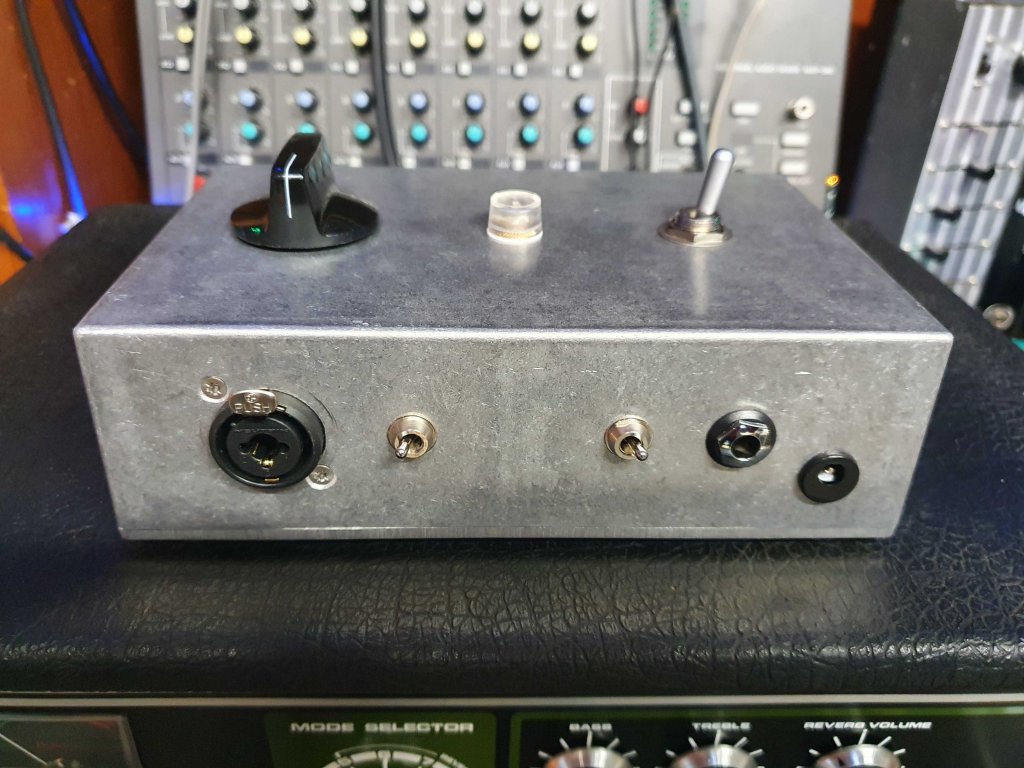
That’s pretty much all for now (and for 2021!). Huge thanks to everyone who has supported this project and provided words of encouragement, or indeed parted with their hard earned cash and ordered. We literally couldn’t do this without you.
Find out more about the Type 636P and order one now for delivery in early 2022.
Or if you want the full Type 636 experience then – at the time of writing – we still have a few preorders remaining for the last build of 10 Soundgas Type 636. This is the final production using refurbished vintage Gibbs spring tanks. Sourcing/restoring the tanks was a massive commitment of time and resources. UPDATE 4th Jan 2022: 8 of the 10 units are now sold!
We have exciting plans for new Soundgas products to develop over the coming year and no resources allocated to further Type 636s. Once those ten are complete, we’ll be busy building the next batches of 636P to satisfy preorders in early June 2022.
Below: the interior of our studio Type 636 showing the completely restored original Gibbs spring tank.
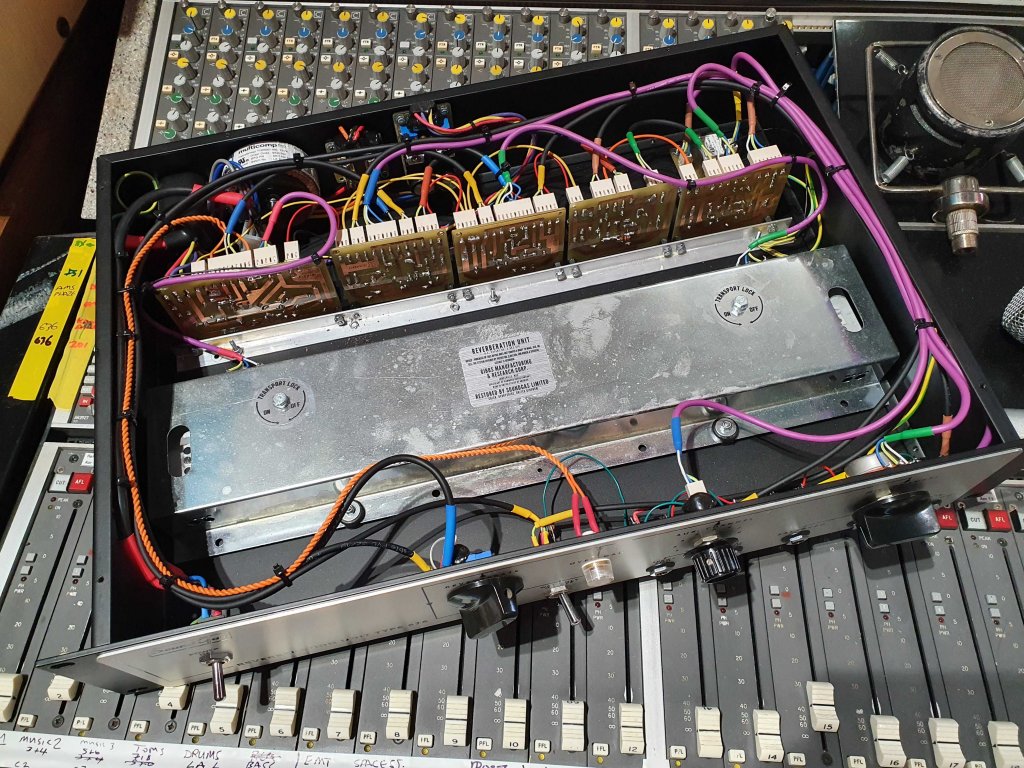
=======
Tony Miln is the co-founder (& Head Gear Head) of Soundgas.
More Grampian & Type 636

Gear feature
Gear History
Grampian Type 636 – Believe the hype…
Grampians: some history and technical information about these superb, legendary machines. If you are looking to buy a Grampian or have one to sell in any...

Grampian Reverberation Unit Type 636
A growing collection of information about the Grampian 636: history, schematics, manuals, sound & video clips; plus our Soundgas Type 636 project to recreate this iconic...

Gear Info
Soundgas News
Grampian & Soundgas Type 636 Q & A Session
Video from the Q&A session we did on the Grampian and Soundgas Type 636 units, plus an update on the Soundgas 636 build. Also Jane Weaver!

Gear Info
Soundgas News
Incoming! The Soundgas Type 636P (Guitar Pedal… or?)
Say hello to the prototype Type 636P: all the heft and magic of the our 636 mic preamp in a compact desktop box.

Grampian User Tips
Some useful info for using a Grampian 636 in a modern studio set up. By no means a full user guide, but this should help you...
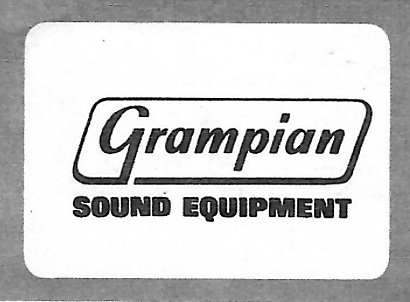
Grampian Type 636 Operating Instructions
Grampian Type 636 Operating Instructions & Technical Specification reproduced into a searchable format.

